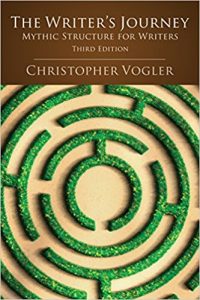The Hero’s Journey and Modern Story Structure
Jonathan Smith // Blog Writer
Humans have always had an insatiable appetite for compelling and relatable stories. Philosophers and writers alike have often tried to categorize the essence of an enduring story, with one of the oldest and most popular works being Aristotle’s Poetics. Modern theory includes works by authors such as Joseph Campbell with his 1949 book The Hero with a Thousand Faces, and Christopher Vogler’s 2007 book The Writer’s Journey: Mythic Structure for Writers. Both of these texts emphasize the importance of the concept of the Hero’s Journey, which requires a protagonist to undergo a series of trials and changes before achieving his or her goal. This general structure, of course, serves as the premise for most novels and movies today, including those most prominent in popular culture.

There are three acts and a total of twelve stages in the Hero’s Journey. Stage one is exposition: a character is in a normal setting and state of mind, a quest arises, the quest is refused, a mentor gives advice, and the character eventually embraces the journey. In stage two, the character faces challenges, approaches the setting where most change will occur, encounters the central dilemma, and captures the reward. In stage three, the character heads back to safety, reflects on the quest, and returns home having changed. This structure is found in various theories, including Freytag’s Pyramid, which views stories in a five-part diagram involving exposition, rising action, climax, falling action, and denouement.
One of the important concepts to note—as Vogler is quick to do in The Writer’s Journey—is that the Hero’s Journey is a general guideline. It is not a structure that every story needs to follow in order to be enticing or compelling. The majority of stories, however, will still use the key elements associated with these stages. A character might start at a difficult place in life and become wealthy in the end; or the opposite may happen, and a character is forced to evaluate himself or herself given their recent experiences. In either case, there is a story arc that helps push the character forward, constantly forcing him or her to interact with the surrounding environment.
Not all stories need to follow a hero’s escapades, of course. They can follow the trajectory of a villain, with added emphasis on why he or she chooses to behave as they do. Or a story can center on a perfectly average person in most respects, with no supernatural or “chosen one” qualities, and still deliver a powerful message. The most important notion to remember when crafting a story is to construct a narrative with multiple moving parts and a dynamic protagonist. A stagnant protagonist, at least in most cases, does not offer excitement for a reader. A protagonist who is forced to make decisions—to act in ways that he or she might otherwise avoid—is crucial to the success of a story.
In my personal experience as an undergraduate writing major, however, I find that it is easy to make the mistake of having weak protagonists when constructing narratives. Early on in my writing career, I often wrote first-person fiction narratives with little to no stakes incumbent upon the protagonist. My reasoning behind this was to have the narrator be someone who, like the reader, is experiencing the story around him or her, seeing how others react to the scenarios at hand. I quickly found the flaws associated with this structure, including a lack of satisfaction on the readers’ behalf at the end of my stories. Vogler’s The Writer’s Journey has been influential as I have grown in my writing career, and is a significant resource when constructing stories of any kind, whether manuscripts or screenplays. What I have found is that this invaluable resource can only help so much, and that it is up to the artist to deliver the nuance and unique qualities that a worthwhile story has to offer.
